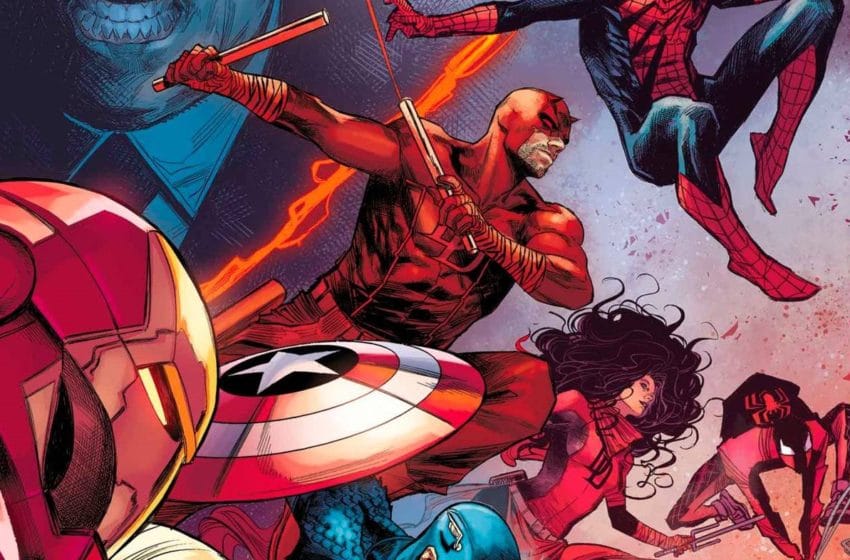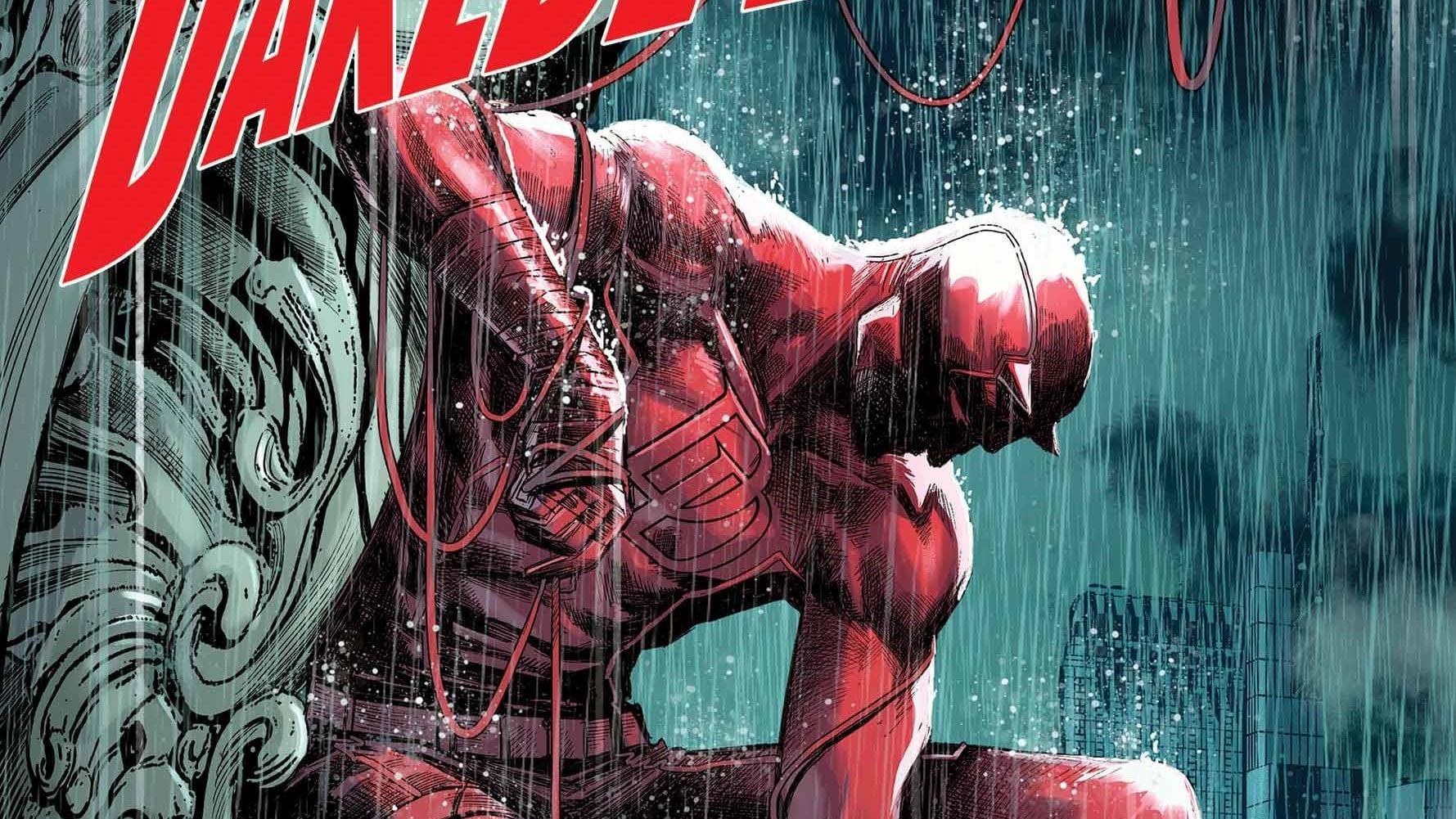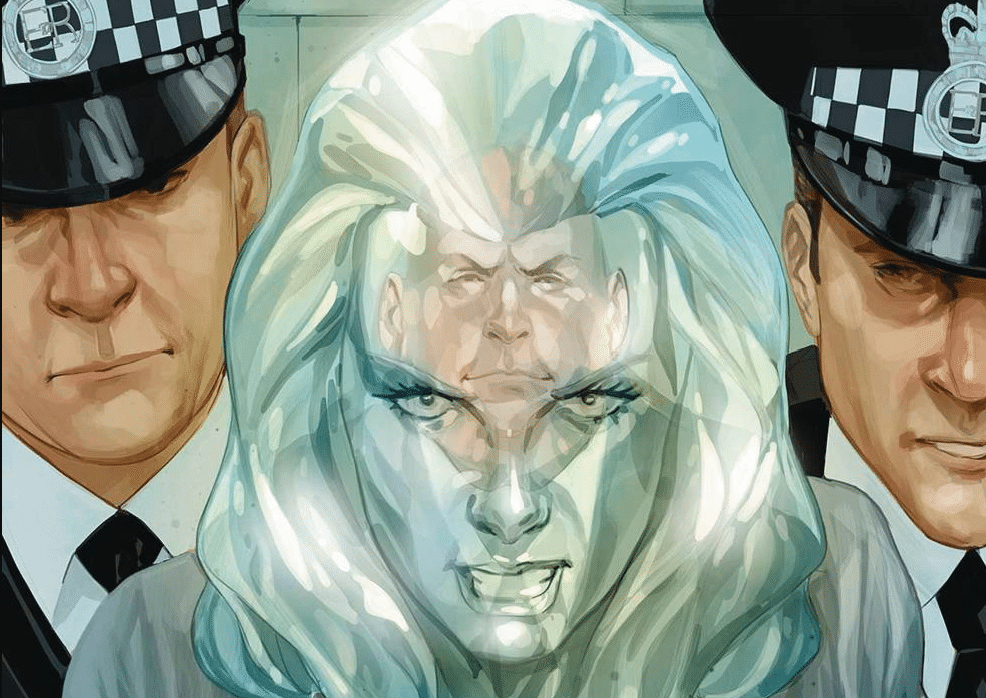Things are getting political and punchy and all kinds of complicated in Devil’s Reign #1. Written by Chip Zdarsky, drawn by Manuel Garcia, colored by Marcio Menyz, and lettered by Clayton Cowles, Devil’s Reign #1 is full of explosive consequences and actual explosions involving Daredevil, Wilson Fisk, and a city of heroes caught in the crosshairs of their conflict.
Anna Peppard: Crossover events are weird. I know they should feel normal. I got hooked on Marvel comics through a crossover event (the original Civil War), and the shared continuity universe is, of course, a defining Marvel thing. But I still find them weird. They’re like regular monthly comics and also something else entirely.
In a way, crossovers are a lot like movie blockbusters. The trailer is so exciting. Everyone who’s anyone watches it five times on their lunch break, and if you consider yourself a fan of the thing that’s getting the blockbuster treatment, there’s a good chance you engage in easter egg-spotting and speculating about what it all means and how it’s all connected. But then the movie happens, and a lot of people are like, “huh. It was better in my head.” Crossover events and blockbusters both struggle to live up to the hype, because it’s their job to build hype. Everything is the next big thing. Everything is must-see/must-read. With comic book crossover events in particular, every event claims it will make you question everything you thought you knew about the characters or permanently change the status quo. But even when events technically deliver on these promises, some shakeups are more well-received than others. Such is the nature of hype and its aftermath.
Which is a long-winded way of saying: for me, reviewing Devil’s Reign is going to be an exercise in not falling prey to the hype trap. At the same time, however, I am going to treat this like an event comic, which means evaluating its good or badness does require evaluating whether it delivers on the “event” label. Event comics have to be bigger. They have to be bolder. They have to be the blockbusters of a genre that’s already a collection of bombastic punch-em-ups.
So is Devil’s Reign #1 a good event comic? I would say “yes,” even if some of its allegories make me nervous and a scene involving Luke Cage makes me angry. I also remain irritated that the plot is so similar to my first Marvel event, which I enjoyed at the time but hasn’t necessarily aged well. But Devil’s Reign #1 is big. It is bold. And Marco Checchetto penciled it, which means (most of it) looks really pretty. Let’s hash out the details.
Inciting Incidents

The Chip Zdarsky-penned Daredevil series, which is the most relevant lead-in to this event, concluded last week with DD’s arch-nemesis Wilson Fisk, the former Kingpin of Hell’s Kitchen and current Mayor of New York (but also still kinda the Kingpin) realizing all the info in his file labelled “Daredevil Identity” is blank or otherwise unreadable. As Matt Murdock explains in this issue, Fisk’s documents are unreadable because the children of Zebediah Killgrave, aka the Purple Man, hypnotized the world into forgetting Matt is Daredevil. Suffice to say—Fisk was displeased by this revelation. This displeasure carries over into the confrontation with Daredevil that kicks off the action in this issue.
But before I get to the substance of DD and Fisk’s confrontation, I want to take a moment to say—dang, that first Checchetto splash page of Daredevil swinging through the city sure is nice. The last handful of Daredevil issues employed fill-in artists who were more than capable, but I feel like I might have forgotten how pretty Checchetto’s DD can look. Sure, Matt’s obliques are distractingly absurd, but the combined power and grace of his body in this image, set against a wall of skyscrapers that emphasize his reckless defiance of the crushing speed and scale of the city, makes me remember, with visceral passion, why I love this ridiculous devil-guy. Daredevil’s prettiness also serves a narrative function, since it’s juxtaposed with Fisk monologuing in caption boxes about how much he hates Daredevil. Through this juxtaposition, we see Fisk’s warped view of reality. But we also see its grain of truth. Visually, Daredevil is, objectively, too perfect, in all the ways our culture measures that where men are concerned—he’s lean, hard, and mobile, with the squarest of square jaws accented by an impossibly impeccable scruffy beard.
Fisk has none of these perfect features (except, perhaps, hardness, though I’d argue his body can more accurately be described as solid). He is not afforded the privilege of that type of conventional physical beauty. Admittedly, this is a problematic trope; villains are less conventionally attractive to signal their villainy, which confirms cultural prejudices yadda yadda yadda. But I’d argue the convention is mostly being used productively here, in ways that don’t quite subvert it but do provoke thought.
But let’s get back to that confrontation. So, Fisk is angry. He is very angry. He spit-yells into Daredevil’s face as he demands to know who he is, his height and bulk bearing down on our fearless hero who is, as one would expect, fearless. The first time I read the issue, Fisk’s over-the-top anger bothered me. It seemed too direct, too hysterical. But on my second read-through, I started to wonder if Fisk was performing this over-the-top anger on purpose. He does, after all, have a long game, communicated through that caption box monologue. Fisk hates what he perceives as Daredevil’s sense of superiority and says he knows his Achilles’ heel—his guilt. And he plans to exploit this superiority and guilt to take Daredevil down.
Later in the issue, we see Fisk’s plan doing its thing. Daredevil is so guilt-ridden about being the source of all the violence that comes from Fisk’s rage, he contemplates giving himself up. This time, his superfriends talk him out of it—but what about next time? I’m not a betting girl, but if I were, I’d put money on Matt trying this stunt again at some point, with predictably disastrous results.
Punchy Politics

One week after yelling at Daredevil on the street, Fisk gives a daytime press conference to a large crowd about his brilliant new plan to ban superheroes in the city of New York. Since pretty much every Marvel superhero lives there, this is a problem! Within his speech, Fisk references as a precedent a current federal law banning superheroes under the age of 21. This happened in the Eve L. Ewing-penned event Outlawed from last year. Don’t remember it? That may be because it got screwed pretty badly by the pandemic. It was slated to debut in May 2020 but was never physically published; it went digital-only over the course of the summer and fall.
Fisk doesn’t explicitly say what will happen to superheroes who violate his new law, later called the “Powers Act,” but the fights that follow involve rounding up superheroes, slapping power-dampeners on them, and taking them away somewhere (I’m sure we’ll find out where in future issues). Most of the action of this comic involves a series of very violent raids on members of the superhero community. Targets include Moon Knight, Spider-Man (Miles Morales), the Fantastic Four, Darkhawk, and Luke Cage and Jessica Jones, with Captain America, the other Spider-Man (Peter Parker), and both Daredevils (Matt Murdock and Elektra) showing up to help.
The enforcement agents are “Thunderbolt Units,” human soldiers specially trained and armed to handle superpowered “threats,” supplemented with the actual Thunderbolts, reformed by Fisk during the “King in Black” event, specifically, the three-issue limited series King in Black: Thunderbolts. Several Thunderbolts members from that series are involved here, along with some new faces, like Doctor Octopus. Otto takes charge of the raid on the Fantastic Four, apparently so he can take possession of what I initially thought was the FF’s Negative Zone portal (where superheroes got imprisoned during Civil War), but my super-smart CXF colleagues inform me is probably, instead, the Forever Gate. Basically: whereas the Negative Zone portal goes one place, the Forever Gate can, in theory, go every place, including every other universe as well as into the future and back in time. (I think into the future/back in time are also alternate universes in Marvel comics? But I don’t want to spend too much time thinking about it. To quoth the great Lindy West, “Time Travel Doesn’t Make Sense and I Think We Should Make it Illegal.”)
The introduction of the Forever Gate creates literally infinite possibilities. Here’s a couple of the likelier ones: Fisk could be gearing up to send the imprisoned superheroes into random alternate universes. Even likelier: we’ll probably be pulling some alternate universe characters into the 616. Plenty of interesting places to go with this, potentially exploding a ground-level event into a cosmic one.
Throughout this comic, the action is suitably bombastic (Checchetto draws a mean Rhino). But I’ve got some reservations about the political allegory that informs all the fighting. It’s not Zdarsky’s fault every American strongman populist in every story now reminds everyone of Donald Trump. But this story also consciously courts Trump comparisons; the conclusion of this issue shows the uber-rich behind-the-scenes powerbrokers Quinn and Una Stromwyn h
displaying a sheaf of “Fisk for President” posters. But here’s the thing: Trump became politically powerful specifically through racism, namely, the so-called “Birther Movement” to uncover Barack Obama’s “real” birth certificate and his plan to build a border wall between the US and Mexico. If you’re doing a Trump allegory, that should be part of the story.
There are moments when Devil’s Reign does seem to be reaching for racial allegory. For instance, it feels relevant that Luke Cage is targeted when he’s not actually superheroing, and a bunch of white heroes save Miles Morales from the cops. But the effort is clumsy, at best. Case in point: Fisk’s speech includes a line in which he accuses superheroes of causing a “rain of dark aliens.” In context, this line refers to the Venom-style symbiotes that flooded the city during “King in Black.” But the unavoidable Trumpian echoes also suggest Fisk is exploiting racial animus in ways that could analogize Marvel’s superheroes—the vast majority of whom are white—as people of color. This was problematic in 60s X-Men and is arguably even more problematic many decades later, when we should all really know better. If this story is going to incorporate racial allegory, I hope it does so more thoughtfully moving forward.
That said—the portrayal of Luke Cage in this issue doesn’t inspire confidence. The coloring of Luke in this comic hews closer to Steve Austin than Mike Colter. If this was the first and only time this type of thing had happened, maybe it wouldn’t be such a big deal. Maybe we could chalk it up to overly dramatic lighting and leave it at that. But as Zoe D. Smith discusses in her series of essays on “4 Colorism” over at Women Write About Comics, American comics have a long and painful history of misrepresenting people of color via inadequate color printing and a lack of attention to this as a problem. Smith specifically discusses how historically, Luke Cage’s “invulnerable skin was often significantly marred by printing error.” Ronald Wimberly’s visual essay “Lighten Up,” describing an incident in which a Marvel editor asked him to lighten the skin tone of Wolverine’s ex-girlfriend Melita Garner, shows colorism is also an ongoing problem within mainstream superhero comics. Many more fans, critics, and scholars have pointed out additional examples of questionable coloring (and casting) choices in recent years.
The coloring of Luke Cage in this comic book is a problem because colorism is a problem. It’s also a problem because this comic book got published without the coloring of Luke Cage being recognized as a problem. Is it a simple mistake? I’d like to think so. But it’s worth noting that all types of prejudice include dehumanization, which starts with a lack of empathy, which starts with not caring enough about perspectives beyond your own. Mistakes happen, it is what it is. Monthly superhero comics are a grind, and most of the people involved are doing their best just to keep up. But we all deserve better. We all deserve fewer “mistakes.”
Old Foes and a New Challenger

If you haven’t been reading Daredevil in recent years, you will not know that Matt Murdock’s once-imaginary twin brother Mike Murdock, whom he used to impersonate back in the wacky Silver Age to throw his friends off the scent of his secret identity, is now, via a combination of Inhuman superpower shenanigans and a magic wishing stone, a real-live boy. His partner in crime, Butch Pharris, the current Kingpin (after seemingly eliminating Izzy Libris in Daredevil #36), is part of the same magical origin; he was brought to life by Mike’s wishing stone (technically a Norn Stone), becoming Mike’s childhood neighbor/best friend (see Daredevil Vol. 6 Annual #1 for the full story). When Daredevil recently went to prison, Matt asked Mike to impersonate him in his civilian life. Mike thinks Matt’s in rehab; the rest of the world (except Foggy and Elektra), think Mike is Matt. Butch, in turn, believes he’s Wilson Fisk’s son, but there’s some lingering uncertainty about this (compounded, of course, by the magic-y stuff).
Most of the Mike and Butch content in this issue catches readers up with what’s been going on in Daredevil. But there are a couple of significant developments, such as Fisk acknowledging Butch as his son; he had not explicitly done this before now. Is Fisk confirming this because he thinks it’s true, or because he finds it useful for Butch to think he thinks it’s true? For drama’s sake, I hope it’s the latter. Butch’s story has been a bit nebulous and repetitive for a while now; I’d like to see this plot take a more decisive, more interesting turn.
There are two other important plot points established in this issue. The first is the revelation that Tony Stark is going to run for Mayor of New York, opposing Fisk. I’m not sure what this does to the political allegory; a battle between rich white guys for the future of New York isn’t the most daring choice, though it is depressingly resonant with federal politics. I’ll hold off judgement for now.
The second important plot point involves Fisk apparently killing the Purple Man, who he’s been keeping inside a super-science tube in his super-science research lab. Event comics generally require “shocking” deaths, and Zebediah is a crowd-pleasing candidate, since, as a character centrally associated with serial rape, he is the absolute worst. This also introduces the possibility of yet more magic-y twists, as Fisk seems to want to harness the Purple Man’s power of mental manipulation for himself. This will undoubtedly ratchet-up Matt Murdock’s guilt given the context discussed above, in which the Purple Children manipulated a whole whack of people without their consent, on Matt’s behalf. This caused a lot of folks close to Matt, including his former girlfriend Kirsten McDuffie, considerable pain. A comeuppance has been a long time coming, and this looks like the start of it.
So where are we, at the end of issue one of this fall’s must-read crossover event? We’ve got a lot of balls in the air that could land or get juggled in a lot of different ways, plus the promise of several big status quo shakeups. Which is why I’m calling this a good event comic, despite some significant reservations. I can say I’m intrigued to see where it goes. I can also say I’m hoping it goes somewhere better with its political allegory, that future issues do much better by Luke Cage, and that Typhoid Mary eventually gets to do more than stand silently at her new husband’s side.
See you in the spinoffs! (Can’t promise I’ll have time to review them all, but I will be reading.)
Marvelous Musings
- The cover for next month’s issue promises Taskmaster. I am usually up for some Taskmaster.
- I didn’t discuss the Stromwyns much in this review, but they represent another potentially interesting wrinkle in the political allegory; class insecurity prompted Fisk to murder one of their associates in a previous issue of Daredevil.
- I’m very curious to know what Elektra and Typhoid Mary think about any of this. We didn’t get much (or any) of their perspectives in this issue, and both of them have been antiheroes in the past, who’ve variously worked with Fisk and opposed him. Whose side will each of them ultimately be on?
- What’s the public’s view of Fisk? Is he popular? I would love to know more about how his message is playing with the people. Marvel’s New York often reads as significantly more conservative than real-life New York, which is another problem with the Trump allegory (it is my understanding that Trump is not currently well-liked in his hometown).

Anna Peppard
Anna is a PhD-haver who writes and talks a lot about representations of gender and sexuality in pop culture, for academic books and journals and places like Shelfdust, The Middle Spaces, and The Walrus. She’s the editor of the award-winning anthology Supersex: Sexuality, Fantasy, and the Superhero and co-hosts the podcasts Three Panel Contrast and Oh Gosh, Oh Golly, Oh Wow!





